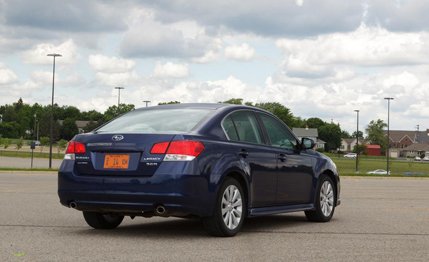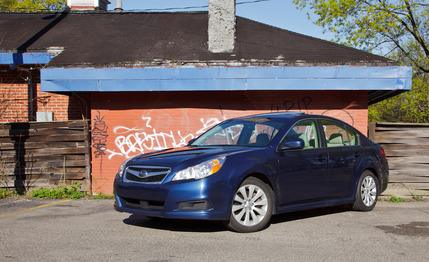 Long-Term Road Test Wrap-Up
Long-Term Road Test Wrap-Up
Date: July 2011
Months in Fleet: 16 months
Current Mileage: 40,164 miles
Average Fuel Economy: 22 mpg
Range: 407 miles
Service: $740
Normal Wear: $349
Repair: $68

After our 2010 Subaru Legacy 3.6R spent 40,000 miles in our care, Subaru chose not to leave the car with us. This is, of course, always the case: Manufacturers whisk their cars away to poke, prod, and otherwise debrief them on what they saw and heard in their months with the Car and Driver staff. But the Legacy surely left a legacy.
It was a legacy of comfort, of open spaces and soft seats, the Scooby earning trunkloads of praise for its long-haul behavior and accommodations. Five people fit without much pinching, and four could stretch out for hours at a time and still feel fresh enough to rave about the plush seats. Speaking of fresh, the interior and lightly colored leather held up well during the car’s stay.
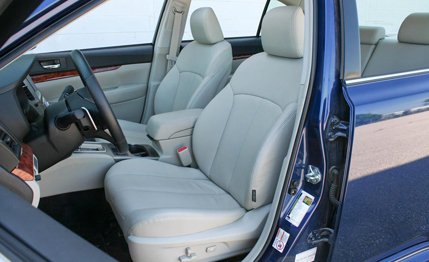
It also left a legacy of enthusiasm, a refusal on the Subie’s part to disappoint those looking for a little fun and adventure behind the wheel of their family four-door. In spite of its cushy suspension, the Legacy’s balance and quick steering relished playing cat and mouse over serpentine stretches. That’s not to say it was a thoroughbred sports sedan, but the jack-of-all-trades sedan was always happy to try.
And it was a legacy of quiet strength—as Teddy Roosevelt was known for saying, “Speak softly and carry a flat-six.” The snarling boxer isn’t the most powerful engine in this class, nor is the Legacy the quickest car among its peers. But after 40,000 miles, it found a 10th in our acceleration tests, dropping its 0-to-60-mph time from 6.4 seconds to 6.3 and its quarter-mile from 15.0 at 94 mph to 14.9 at 95. Although we wanted a bit more volume for its voice, that’s not a sentiment shared by many buyers in the Camry segment, and the flat-six’s unique sound at least held our attention. Its flood of torque was sufficient to keep complaints about the transmission’s having only five ratios—in an era of six or more—at bay. We found joy in the slushbox’s paddle shifters and impersonation of a rev-matching automated manual gearbox on downshifts.
Unfortunately, our Subaru’s legacy was also one of aggravation.
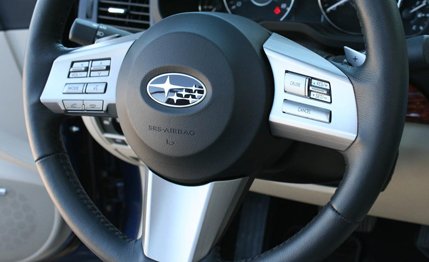
We Interrupt This Broadcast for This Very Important Background
Before the negatives begin, a quick recap: The Legacy was redesigned for 2010 as a larger car to better take on class leaders like the Honda Accord and Toyota Camry. Subaru stretched the model 1.4 inches and rolled the front and rear axles 3.2 inches farther apart, creating a vastly more spacious interior, particularly in the back seat. As enamored caretakers of a previous-generation Legacy, we were disappointed to see what had been a WRX for big kids now bloated, softened, and wrapped in funny-looking sheetmetal, but customers responded with more enthusiasm, and sales increased in 2010.
In hopes that the Subaru spirit still dwelled within this focused Camry fighter, we ordered one up. With a car aimed at conquering a money-conscious segment, the responsible thing to do would have been to go for the 2.5-liter naturally aspirated flat-four. But since when is responsibility fun? A turbocharged 2.5-liter four sits on the next rung up the ladder, but we sampled that engine in our last long-term Legacy and decided on the 3.6-liter flat-six. As installed in the $28,690 Legacy 3.6R Limited, this engine makes 256 hp and 247 lb-ft of torque.
As You Were
With 1117 miles on the odometer, a slight vibration during hard acceleration and at highway speeds had us sitting in the local Discount Tire awaiting a rebalance. Sixty-eight dollars later, we were back on the road—and the shimmy was back in the steering column. After 10 days of trying to ignore it, we went back to Discount. There it was determined that all four wheels were in balance, and we were not charged. A tire rotation and basic inspection during the first service failed to turn up any problems, so with action ruled out as a solution, we went back to pretending the shimmy wasn’t there. It was a minor tremor, so this worked well enough, but all were happy when the winter tires went on at 18,264 miles, since their softer compound dampened the steering column’s shivers.
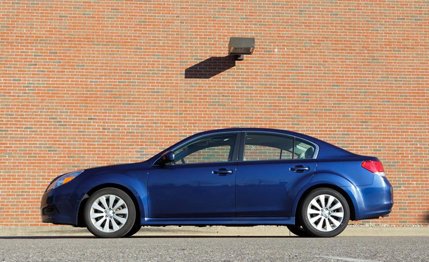
The Legacy accumulated miles at a rare pace during the first months of winter, its all-wheel drive and grippy Bridgestone Blizzaks making it the go-to choice for two February forays into Wisconsin, a spur into upstate New York, and a snow-fleeing jog south to the Carolinas. The squishier rubber helped on one front but left us with another complaint: At speed, the car refused to travel in a straight line, meandering after pavement grooves and road crowns. Still, the Legacy stashed away more than 12,000 miles over four months of Midwestern winter.
As the weather warmed, though, complaints about the Legacy shifted from its highway-onset attention-deficit disorder to clunks and crunches from the front end over larger bumps. Not long after the all-season tires went back on at the end of March, a visit to the dealer at 36,417 miles revealed bad anti-roll-bar bushings up front. This ignited hope that perhaps the constant shiver of the steering wheel was somehow rooted in this. The dealer ordered bushings, but not the right ones, so it wasn’t until we’d added another 2300 miles to the odometer that we finally had the problem repaired. The clunking, we mean. The vibration persisted.
We’re Not Talking Tuberculosis
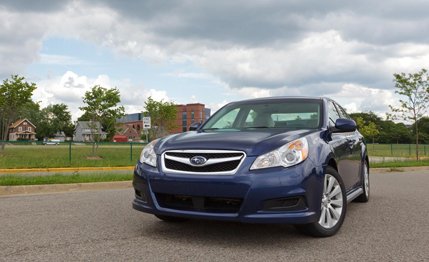
Not only did the vibration persist, but during our Legacy’s last scheduled service, excessive oil usage—we had to add 7.5 quarts over the car’s stay—forced the dealer to conduct a consumption test. No highly technical assessment this, it simply involves ensuring the vehicle has the appropriate amount of oil in the crankcase and reporting back to the dealership in 1000 miles. If it burns more than a quart, mechanics pull the engine, and things get much more involved. As a final knife twist, while rotating the tires—part of every scheduled service—a tech stripped a lug on the left front wheel.
Our car passed the consumption test, burning through only a quarter of a quart over the prescribed interval. This experience, however, coupled with the fact that the engine and transmission had to be pulled from our long-term Subaru WRX STI, had our nerves shaken. The dealer naturally replaced the stripped lug free of charge.
No Legacy Is an Island
All of this is not to say that our time with the Legacy was one long disappointment. It says a great deal about the car that it was so widely praised—and so frequently employed as a road tripper—in spite of having a steering wheel that shook like a frightened field mouse, and it never failed to get us to a destination. But our issue with the car was not a lonely burden, with the same shimmy issue popping up repeatedly in Legacy owner forums. Subaru’s response seems to be aimed more at minimizing the effects than actually solving the problem, which we find disheartening. For a car that’s otherwise very satisfying, that’s an unfortunate legacy.
